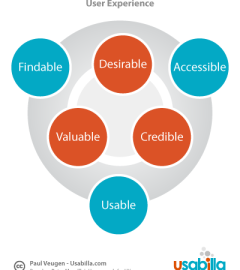
UX is based on 200 years of scientific knowledge, 30 years of industry best practices and specifically applied research. – @mashable
User experience (ux) is an emerging practice that sits at the intersection of behavioral science, web development, and domain-specific knowledge. It’s a human-centric approach to understanding how people engage with technology, and how to build the best web experiences possible. Consider the following:
88% of online consumers are less likely to return to a site after a bad experience. -@econsultancy
94% of a user’s first impressions are design-related. – @Veopix
73% of consumers access websites on their mobile devices. – @Bond_Group
The best user experience practice comes from a deep knowledge of buyer personas. According to usability.gov, businesses must couple this deep knowledge of users with information that is:
Useful: Your website should deliver specific value to specific buyers.
Usable: The site should be easy-to-navigate on all devices.
Desirable: Your design must be attractive, intelligent, and easy to look at.
Findable: Users should have no problems finding key information through navigation and search.
Accessible: Your content needs to be accessible to people with disabilities.
Credible: Your site needs authority and sufficient quality of content to be believable.
The practice of user experience spans multiple disciplines, including buyer research, information architecture and knowledge management, interactive design, and visual design. While it’s certainly complex, it’s not optional for organizations.
Consider the following recent statistics that demonstrate just how critical user experience is at organizations of every size:
Every $ 1 invested in UX can have a return of up to $ 100 for your business. – @UXmotel
User experience carries a significant, measurable ROI for organizations. It’s not a benefit to users, it’s a benefit to your brand. Consumers want to interact repeatedly with websites that are pleasingly designed and easy to navigate, which is why brands with exceptional UX win repeat visits, and eventually, new customers.
A 1-second response keeps users engaged with the content, thereby increasing the conversion rate and reducing abandonments. – @SmashingMag
You’ve heard that your website needs to be rapid fast, especially on mobile, to keep your abandonment rate low. But did you know it needs to load pages in one second to optimize for conversions? Simplify, reduce file size, and remove extraneous elements until you’ve optimized for load times.
87% of Fortune 500 companies have an easy to find search field on their homepage. – @GoGulf
If your website contains much content, it should be easy to search. Your search field shouldn’t be buried at the bottom of your homepage, or in the sidebar of your internal pages. Your search functionality needs to be prominent, so users can direct their own website experience.
85% of UX problems can be solved by testing with 5 users. – @UltraLinx
If you’re not user testing your company website, you’re actually in the minority. Currently, 55% of organizations conduct user testing, which consists of enlisting non-technical users to evaluate the usability, feel, and experience of web design.
Answers to your company’s most frustrating user experience problems might not come from your web development team, who are often too close to the issue to be objective. More likely, they’ll come from external users who can look at the site with fresh eyes and offer feedback.
Nearly three quarters (73%) of companies currently not conducting user experience testing will be doing so in the next 12 months. -@econsultancy
User experience testing simply makes sense, particularly for organizations with the insight to test among their current customers. By leveraging individuals who fit your buyer persona profiles, you can gain specific understanding of how your user’s technical capabilities and needs intersect with your web design.
It’s clear from eConsultancy’s research that organizations worldwide are clueing into the immense value of user testing, in addition to testing by members of your web development team.
57% of users say they won’t recommend a business with a poorly designed mobile site. – @Google
Did you know that your organization’s lack of a mobile-optimized website could affect your net promoter score, a key performance indicator of customer satisfaction? Even if your brand’s products are top-notch, your customer service is exceptional, and your customers intend to continue buying, they may hesitate before sending their friends and peers your way. Referrals are a key source of cost-effective customer acquisition for brands worldwide, and user experience should not affect your ability to win repeat buyers.
47% of websites have a clear call-to-action button that takes users 3 seconds or less to see. -@GoGlobe
When customers land on your homepage, what should they do? Should they sign up for a free trial, check out your case studies, or dive into the high-quality content on your company blog? You may choose to have a rotating slideshow of calls-to-action, or better yet, present a dynamic call-to-action based on a user’s previous interaction history with your website. Regardless of what you opt for, your CTA should be above the fold, visible, and clearly resemble a button.
More and more mobile apps use smartphone sensors to know where you are and what you are doing enabling devices to provide users with highly personalized benefits. – @Scobleizer
Increasingly, user experience involves a little “something extra,” which is often personalization. Today’s brightest brands are exploring ways to provide truly individualized browsing experiences to their customers, which often involves location or user-centric content.
Can you offer localized discounts or tips to your users? Purchase suggestions based on their buying history? Reading recommendations based on prior whitepaper downloads? When correctly leveraged, personalization in marketing can provide a massive amount of value to consumers.
More than nine out of 10 (95%) agreed with the statement that ‘good user experience just makes sense.’ – @eConsultancy
Organizations are beginning to see the immense value in user experience optimization. And really, it does make sense. A positive user experience on your website is powerful marketing. Better yet, it’s good prospect and customer service. Organizing your navigation and content in a way that’s easy to find, regardless of what device your customers are using to access your website, shows that you care about their experience online.
Is your organization invested in user experience optimization and testing? Why do you think this practice is crucial?
(246)






